
Rye Breads Class
This past Friday, I taught a class on rye breads at the Culinary Center of Kansas City. The class was scheduled to run from 10:00 a.m. to 3:00 p.m. Three different breads were featured: the rustic pumpernickel from ITJB, Eric's fav rye (compliments of the late Eric Hanner), and a vort limpa. That gave a nice sampling of the diversity of rye breads. We were able to bake both the pumpernickel and the vort limpa during class; students then took the dough for Eric's fav rye with them to bake at home.
I had had some concerns about the drawing power of a full-day class on a week day. As it turned out, all 20 slots were taken, with a waiting list in case of any cancellations. So, yes, there is enough interest, in spite of the schedule. No doubt the inclusion of a $20 gift certificate for Pryde's of Westport, a local kitchen supply store, figured favorably, too.
A number of the students were familiar to me from previous classes, which makes for a pleasant time. Based on what I saw and heard, and what came through on the feedback forms, it was a fun day for the students as well as for me. Most were new to rye breads and to sourdough, so they were pleased to gain some new experience and to receive some starter to take home to use for future baking.
One of the Center's requirements is that the instructor provide food for the students. In the case of an evening or half-day class, that is typically something to snack on; usually whatever is being made in the class. In the case of an all-day class like this one, it is lunch. It was a no-brainer to plan lunch around the three breads being taught. That led to cold cuts and condiments and pickles/olives/peppers, with fresh fruit for dessert.
Consequently, I needed to bake bread ahead of time to have it ready for the lunch of Friday. That worked well, since it also did double duty as object lesson so that people could see the finished product, too.
If you have baked the rustic pumpernickel from ITJB, you know that it is dark and dense and fragrant with rye. There's no molasses, coffee, cocoa, or caramel color in it, nor does it have a prolonged bake. My belief is that the scald contributes strongly to the dark coloring and the moistness of the finished bread. Then, too, all I can find in local supermarkets is Hodgson Mills stone-ground rye flour, which is pretty hearty stuff in its own right. Even with heavy steam, the loaf experienced some cracking but no blowouts.
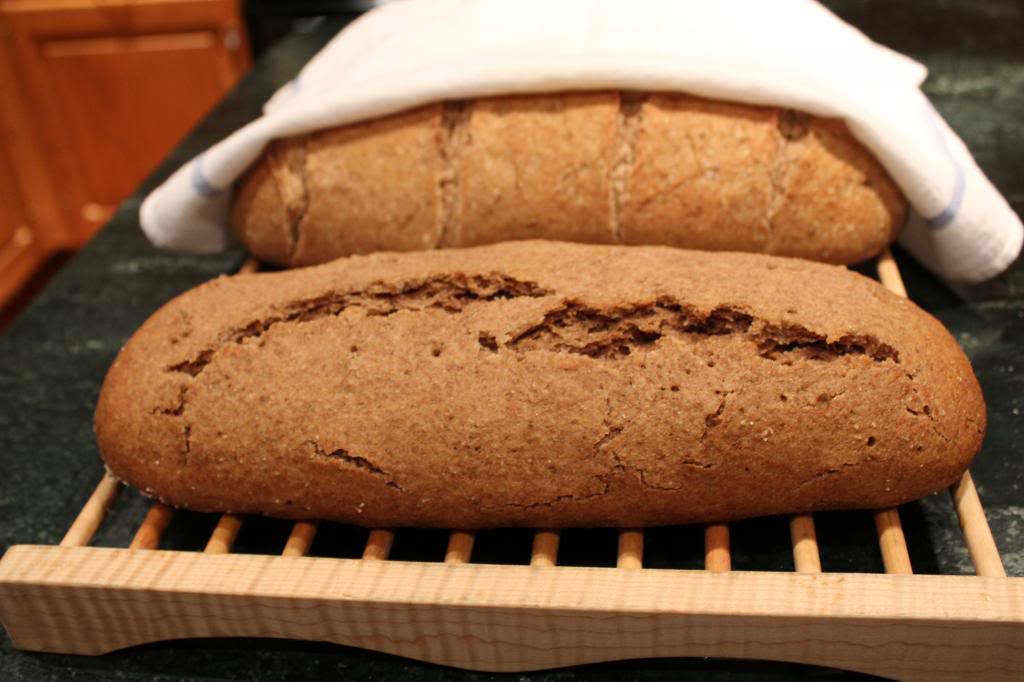
The vort limpa is a party in a compact loaf. It is redolent of molasses, orange zest/juice, anise, fennel, cardamom, and beer. With a smear of sweet butter, it's practically dessert. And it still makes for some darn good sandwiches and toast, too.
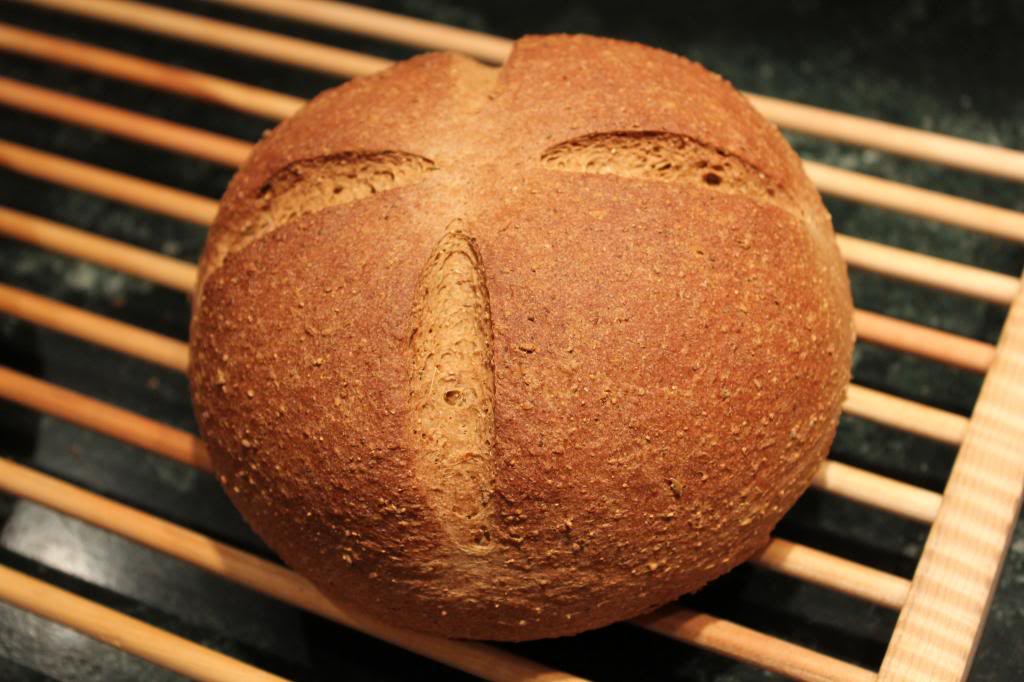
Many, many of you have made Eric's fav rye and know that it is a stellar example of a deli-style rye bread. It makes a magnificent base for a wide range of sandwiches. While I enjoy the bite of the caraway, my wife often prefers it when I substitute either fennel seeds or dill seeds for the caraway. No matter how you tweak it, this is a seriously good bread.
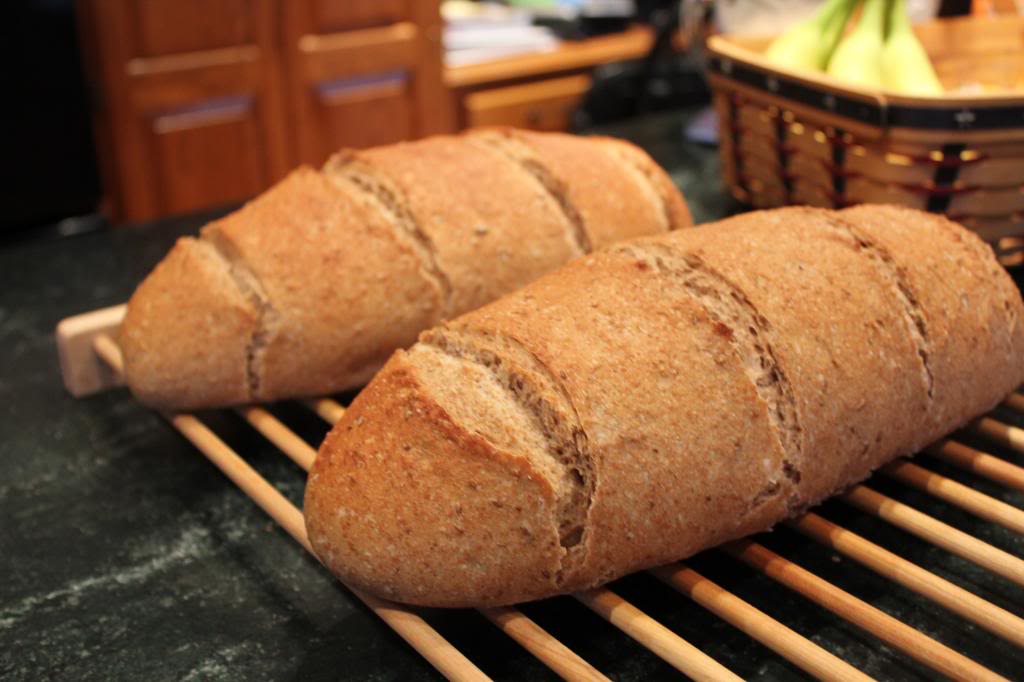
With those out of the way, I needed to build up my starter to have sufficient for 21 batches (20 students + 1 instructor demo) of the pumpernickel and Eric's fav rye, plus enough to give away. That turns out to be a lot of starter. Really, really, a lot. Keep in mind that this class was initially planned last summer. At that time, I was focused more on pulling together the bread descriptions for inclusion in the advertising and the formulae to go into the student's class booklets. There should have been some thought given to the amount of prep. I know that now. Yes, I do.
For instance, this is what all of the scald for the pumpernickel looks like with half of the sponge incorporated. You can see that it occupies most of one end of my kitchen's island:
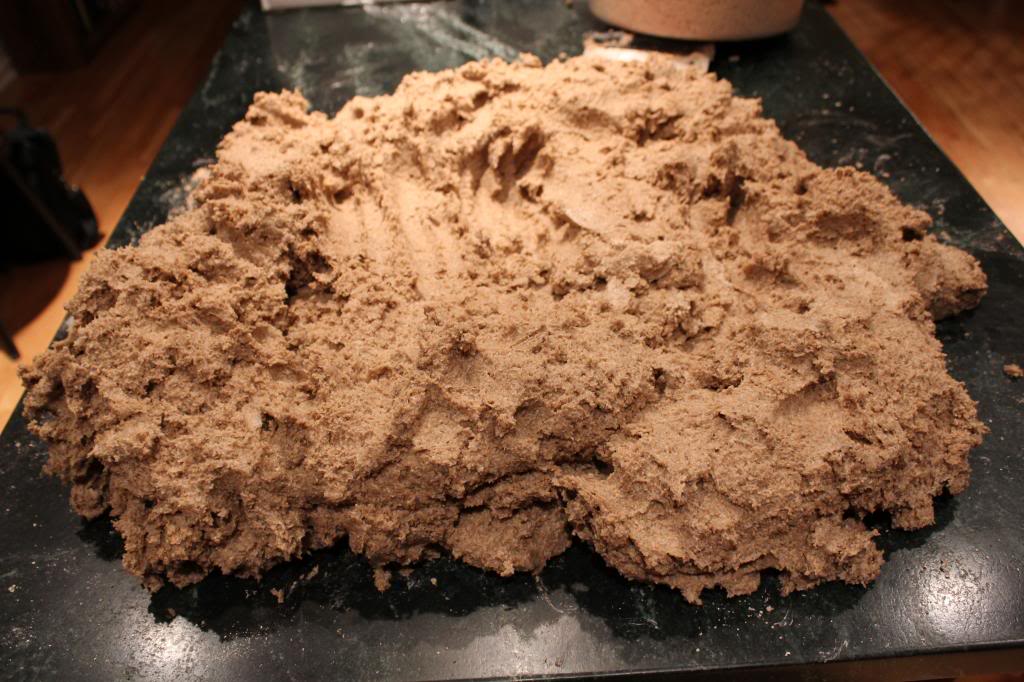
The lighting isn't very good; it's all down light from the ceiling and island light fixtures. There isn't a lot of ambient light at 6 a.m. in January here in Kansas.
This is the second half of the pumpernickel's sponge, ready to mix in with the scald; nothing but rye flour and water, and it smells wonderful!:
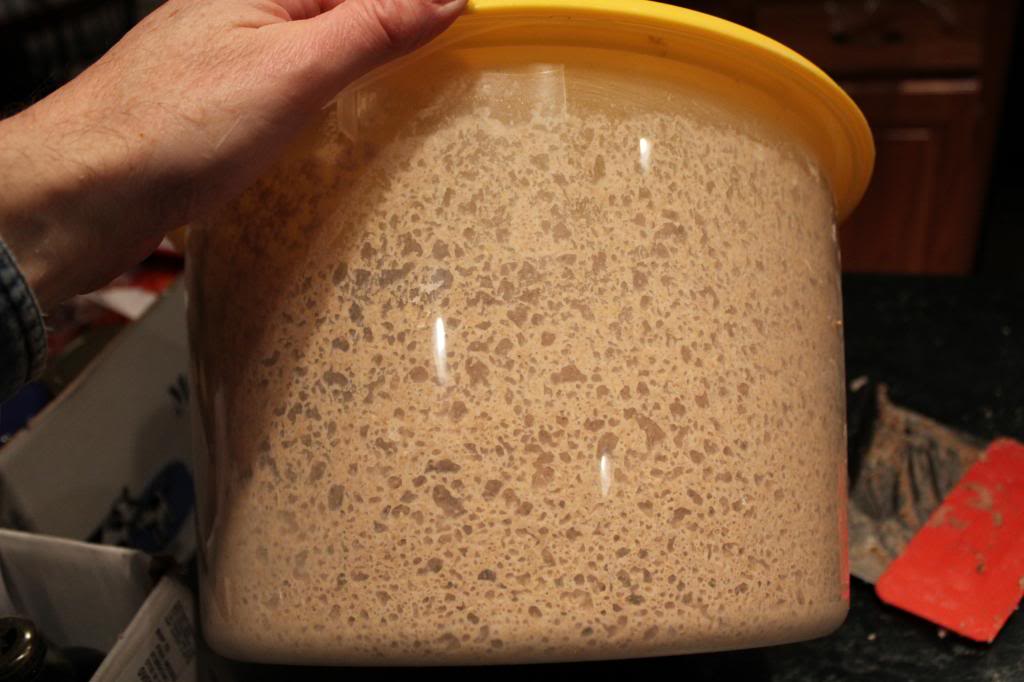
Sponge and scald, ready for the final mix (I could have used a big spiral mixer right about now). Note that the sponge is lighter in color than the scald, even though both are made with the same flour:
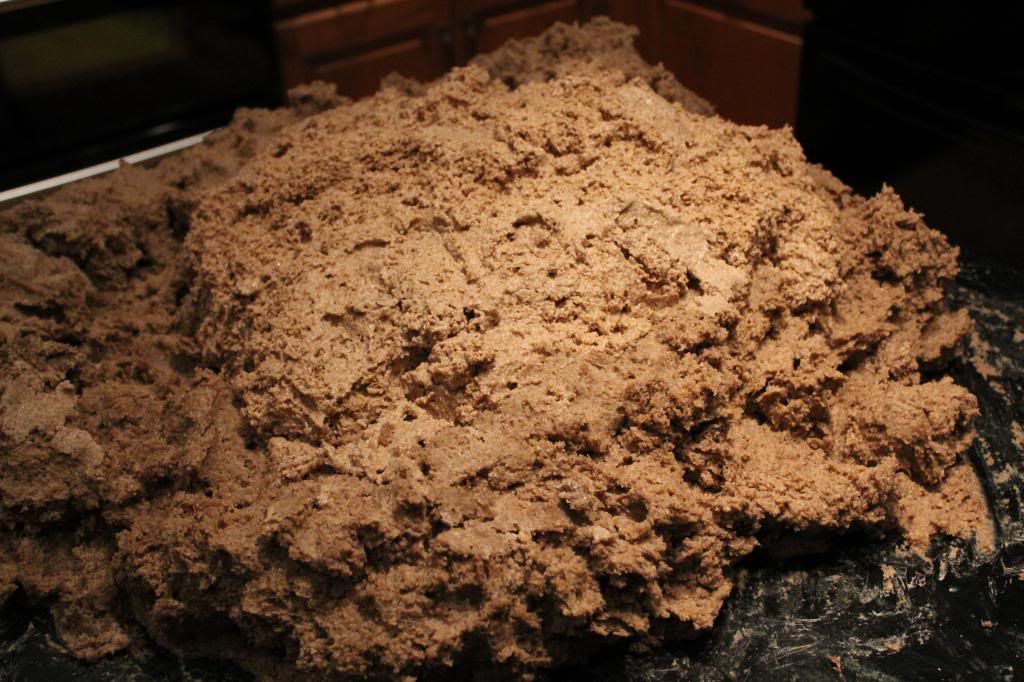
Needless to say, it took a number of trips to schlep all of the ingredients from my kitchen to the car, and then again from the car into the teaching kitchen. I suspect that we will rerun this class at some future date but there may be a change in the lineup that reduces the amount of prep I have to do.
There aren't any photos of the actual class. I didn't think to grab my camera on the way out the door and there wasn't time to use it, anyway.
My students were an interesting group. The youngest may have been in their late 20s or early 30s. The oldest were, well, older than me and I'm 57. One couple took a day off from work to attend. All were alert and inquisitive, with lots of good questions. We had a lively discussion about how to begin and maintain a starter, which would have been shorter if I hadn't misunderstood a key part of one inquiry. ;0 During the course of the day, there were a lot of questions about dough consistency and how it was affected by the amount of flour or water people worked into their doughs. I had talked at length about how sticky some of the doughs would be and not to try to kill the stickiness with flour. A few still wound up with some stiff doughs that needed more water. Some students were almost completely new to bread making while others had some good skills. Tips on shaping and docking and slashing led to another flurry of questions. These are all areas where the hands-on aspect is hugely valuable, since a book just cannot provide that tactile feedback.
It was very satisfying to share these breads with such an eager group of learners. And it was a very full day. I was happy to climb into bed that evening.
Since one student was a no-show, and since I had intentionally made more starter than I expected to use, I wound up making a double batch of Eric's fav rye on Saturday and a double batch of Hamelman's sourdough walnut raisin rye on Sunday. We have happy friends.
Paul


Comments
Paul,
Sounds like it was a wonderful class. Too bad KC is so far away, it'd be fun to participate. Any plans to do another class soon?
Next up is a bread class for kids, in February. That'll be a different twist.
Paul
Paul,
Kudos to you for your recent rye bread class. It sounds like it was very informative and everyone had alot of fun, too. Teaching a class really solidifies your understanding of a subject and brings a whole new perspective to any topic.
Linda
No matter what I teach, it is always an editing exercise because there is so much information that I want to pass to my students and only so much time in which to do it. Consequently, all of the preparation leads to my having learned more than my students do.
Paul
a real fun, Paul. What a pity it was at the other end of the world!
The breads look gorgeous. I would have liked to dive my hands in the dough.
Some of the doughs, the pumpernickel in particular, would have gripped you as much as you gripped it. And they taste every bit as good as they look.
Paul
Paul, what consistence did you give to the pumpernickel dough? For a coincidence 2 days ago I baked a pumper myself making the dough as stiff as possible. Although it was very tough in 1 hour time it almost doubled. The sour had been going on for 10 days:-)
You might have been able to remove paint with that, Nico. Apparently it had leavening power to burn if it doubled your pumpernickel in about an hour.
The rustic pumpernickel I worked with has rye sour at about 72% hydration. It also has a scald at 111% hydration. With the addition of a small amount of rye flour and some bread flour, the final dough hydration drops to about 77% hydration. That's with a stone-ground whole rye flour, so it's pretty stiff. It stands up on its own when shaped although it does tend to slump slightly during the final fermentation.
Paul
I guess we ended up with very similar doughs, although I envy the nutty color of your dough and bread. Mine is a darker brown.
to aromatic heaven! Not to mention the baking aromas! I can only dream! Sounds like a great day!
Enjoy the high from all the baking and after baking. Happy friends for sure! :)
as I was inhaling the rye perfume. Since it took three days of builds to get the required amount, the aroma was just short of eye-watering when I pulled the lids off the tubs Friday morning. My normally mild-mannered starter turned into a beast with a steady diet of rye!
And yes, the baking aromas! Absolutely heavenly! No department store perfume counter ever smelled so good.
Paul
P.S. As I was placing bag after bag of rye flour on the belt for the cashier to ring up, the guy in front of me asked "Do you have a still in your basement?"
Three builds >>> naturally... XXX !!!
But Nico might have a still, and if not I think he could capture the steam coming off his baking and condense it for some real home brew! Lol! Wow..10! There is an aroma cloud that is unique when alcohol is being distilled from fermenting organics. Hate to see you blow up your kitchen, Nico, searching the the maximum sour. Thinking about it... a still in the cellar is a bad idea (that guy was clearly remarking off the cuff) one could succumb to CO2 gasses if there is no way for the heavy gas to flow out of the cellar. If one were to go underground, one should do it on a hillside.
a new line of perfume:-). Imagine going around with this intense aromatic alcoholic/fermented scent all around you:). Don't mind for my kitchen, I do much worse things than that like baking and cooking full time!
but the market niche is very small, Nico. Mostly us TLFers, I think.
Maybe one that smells like just-baked bread? Just about everybody likes that!
Paul
Paul, I'm impressed that you filled up a rye class held in the middle of the week. Sometimes it seems to me that Americans think of Rye as an exotic beast, or have never tasted it at all. Your breads look great, and I'm sure you learned a lot as well as your students, and next time it will be easier. -Varda
When I asked Heather, my helper for the day, about it, she told me that the center has a small group of customers who consistently prod them for more week-day offerings. Apparently those customers are as dedicated in showing up when something is available as they are in asking for it.
Many Americans don't have much knowledge or understanding of good rye breads. That isn't a big surprise, when you consider how many are unacquainted with good bread, in general. One student, for instance, asked why the "pumpernickel" bread in stores is so dark, so we talked about caramel coloring and other materials that people put into breads to make them look "authentic". Everyone made sure they tasted all three of the breads we made and were impressed by how different (and how good!) each was. I had asked at one point early on if there were any who didn't like the taste of caraway, since many people equate that as being the flavor of rye bread. Surprisingly, no one professed a dislike, although there were a couple of blank "What is caraway and what does it taste like?" looks.
Thanks for your comments.
Paul
Your students have to be satisfied with their learning about rye breads and their successes with it. These are 3 really nice ryes for them to get acquainted with and enjoy.
Nice baking and teaching Paul.
Since all of the breads are in varying shades of brown, I'm sure that you would have enjoyed them, too.
Paul
They are my kind of breads for sure Paul...but baked some panettone yesterday :-)